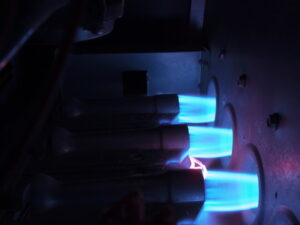
What component are we talking about? Well, one that is essential to your furnace or gas-powered heater: the heat exchanger.
Gas-powered furnaces are the most popular types of heating systems used throughout the country, and for good reason. Natural gas is a very cost-efficient fuel source when compared to its electric counterpart. Since most homes also have ductwork running through them for central air conditioning, furnaces are also more popular than boilers.
That said, if you’re one of the many furnace users, there are some things you should know! First off, today’s furnaces are built to the highest safety standards. They’ll operate even more safely if you stay on top of your annual maintenance sessions. But it’s important to keep in mind that even the most efficient and well-cared-for gas heater has the potential for danger, such as gas leaks or combustion problems, particularly as they age. If your furnace is acting up or completely out of service, here are ways to stay warm until it’s fixed. The biggest and most important repair need we see in older furnaces is the aforementioned cracked heat exchanger.
What a Heat Exchanger Is
Of course, we can’t expect our customers to take this problem seriously if you don’t even know what a heat exchanger is, right? Basically, it is the component inside your gas furnace actually responsible for the heat you feel in your home. What it does is apply heat to the air that your blower fan sends through the ductwork.
The heat exchanger resembles a metal chamber, or series of metal chambers, shaped sort of like a clam shell, and this is where the hot combustion gasses from the burners collect. The heat from the burners raises the temperature of the metal walls, making the exchangers very hot. Then air blows around the heat exchanger, picking up that heat to send it through your ductwork.
Throughout this process, the gas used to light the burners never makes contact with the air going into your home, and instead gets sent through a flue outside—ideally.
The Cracked Heat Exchanger
Heat exchangers go through a lot of stress throughout the years. Each time they’re heated, their metal walls expand. This means that throughout the service life of your heater, the exchangers expand and contract hundreds upon hundreds of times. This can eventually cause corrosion, which leads to small fissures in the metal walls. Don’t ignore these late-season HVAC issues, as waiting too long could worsen the condition of critical components like the heat exchanger.
These fissures are microscopic when the heat exchangers are cool, but widen when the metal heats up again. In fact, the fissures or cracks are so tiny when your furnace is off that you could probably pour water onto a heat exchanger and not a drop would go through (please don’t experiment with this). But when the cracks widen, it allows harmful combustion gasses through, where they make contact with your indoor air coming through the vents.
The most harmful of these gasses is carbon monoxide or CO. CO leaks lead to illnesses and in severe cases even fatalities.
An absolutely vital part of preventing this dangerous problem is keeping up on your annual maintenance appointments. Among many other inspection points, your heat exchangers are definitely something we’ll look at. If your furnace is 15+ years of age, it may be time to consider an upgrade, for your safety and for efficiency. You might also explore the benefits of late-season AC maintenance to keep your HVAC system running smoothly year-round.
Cool Care Heating and Air Conditioning is your trusted resource for heating repair in Houston, TX. Contact us today!




